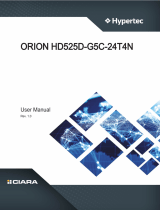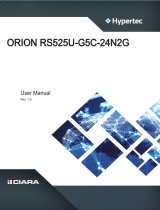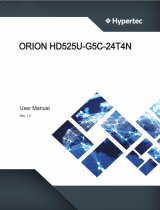Page is loading ...

E162-220
Edge Server – 1U UP system with GPU supported
User Manual
Rev. 1.0

Copyright
© 2021 GIGA-BYTE TECHNOLOGY CO., LTD. All rights reserved.
The trademarks mentioned in this manual are legally registered to their respective owners.
Disclaimer
Information in this manual is protected by copyright laws and is the property of GIGABYTE.
Changes to the specications and features in this manual may be made by GIGABYTE without
prior notice. No part of this manual may be reproduced, copied, translated, transmitted, or
published in any form or by any means without GIGABYTE's prior written permission.
Documentation Classications
In order to assist in the use of this product, GIGABYTE provides the following types of documentation:
User Manual: detailed information & steps about the installation, conguration and use of this
product (e.g. motherboard, server barebones), covering hardware and BIOS.
User Guide: detailed information about the installation & use of an add-on hardware or
software component (e.g. BMC rmware, rail-kit) compatible with this product.
Quick Installation Guide: a short guide with visual diagrams that you can reference easily for
installation purposes of this product (e.g. motherboard, server barebones).
Please see the support section of the online product page to check the current availability of these
documents.
For More Information
For related product specications, the latest rmware and software, and other information please visit our website at
http://www.gigabyte.com
For GIGABYTE distributors and resellers, additional sales & marketing materials are available from our reseller
portal: http://reseller.b2b.gigabyte.com
For further technical assistance, please contact your GIGABYTE representative or visit
https://esupport.gigabyte.com/ to create a new support ticket
For any general sales or marketing enquiries, you may also message GIGABYTE server directly by email:
server[email protected]

Conventions
The following conventions are used in this user's guide:
NOTE!
Gives bits and pieces of additional
information related to the current topic.
CAUTION!
Gives precautionary measures to
avoid possible hardware or software problems.
WARNING!
Alerts you to any damage that might
result from doing or not doing specic actions.

Server Warnings and Cautions
Before installing a server, be sure that you understand the following warnings and cautions.
WARNING!
To reduce the risk of electric shock or damage to the equipment:
• Do not disable the power cord grounding plug. The grounding plug is an important safety
feature.
• Plug the power cord into a grounded (earthed) electrical outlet that is easily accessible at all
times.
• Unplug all the power cords from the power supplies to disconnect power to the equipment.
• Shock Hazard! Disconnect all power supply cords before servicing.
• Do not route the power cord where it can be walked on or pinched by items placed against it.
Pay particular attention to the plug, electrical outlet, and the point where the cord extends from
the server.
WARNING!
To reduce the risk of personal injury from hot surfaces, allow the drives
and the internal system components to cool before touching them.
WARNING!
This server is equipped with high speed fans. Keep away from hazardous
moving fan blades during servicing.
WARNING!
This equipment is not suitable for use in locations where children are
likely to be present.
WARNING!
This equipment is intended to be used in Restrict Access Location. The
access can only be gained by Skilled person.
Only authorized by well trained professional person can access the
restrict access location.
CAUTION!
• Do not operate the server for long periods with the access panel open or removed.
Operating the server in this manner results in improper airow and improper cooling that can
lead to thermal damage.
• Danger of explosion if battery is incorrectly replaced.
• Replace only with the same or equivalent type recommended by the manufacturer.
• Dispose of used batteries according to the manufacturer’s instructions.

Electrostatic Discharge (ESD)
CAUTION!
ESD CAN DAMAGE DRIVES, BOARDS, AND OTHER PARTS. WE RECOMMEND THAT YOU
PERFORM ALL PROCEDURES AT AN ESD WORKSTATION. IF ONE IS NOT AVAILABLE,
PROVIDE SOME ESD PROTECTION BY WEARING AN ANTI-STATIC WRIST STRAP AT-
TACHED TO CHASSIS GROUND -- ANY UNPAINTED METAL SURFACE -- ON YOUR SERVER
WHEN HANDLING PARTS.
Always handle boards carefully. They can be extremely sensitive to ESD. Hold boards only by
their edges without any component and pin touching. After removing a board from its protective
wrapper or from the system, place the board component side up on a grounded, static free sur-
face. Use a conductive foam pad if available but not the board wrapper. Do not slide board over
any surface.
System power on/o: To remove power from system, you must remove the system from
rack. Make sure the system is removed from the rack before opening the chassis, adding, or
removing any non hot-plug components.
Hazardous conditions, devices and cables: Hazardous electrical conditions may be
present on power, telephone, and communication cables. Turn off the system and discon-nect
the cables attached to the system before servicing it. Otherwise, personal injury or equipment
damage can result.
Electrostatic discharge (ESD) and ESD protection: ESD can damage drives,
boards, and other parts. We recommend that you perform all procedures in this chapter only at
an ESD workstation. If one is not available, provide some ESD protection by wearing an antistatic
wrist strap attached to chassis ground (any unpainted metal surface on the server) when handling
parts.
ESD and handling boards: Always handle boards carefully. They can be extremely
sensi-tive to electrostatic discharge (ESD). Hold boards only by their edges. After removing a
board from its protective wrapper or from the system, place the board component side up on a
grounded, static free surface. Use a conductive foam pad if available but not the board wrapper.
Do not slide board over any surface.
Installing or removing jumpers: A jumper is a small plastic encased conductor that slips
over two jumper pins. Some jumpers have a small tab on top that can be gripped with n-gertips
or with a pair of ne needle nosed pliers. If the jumpers do not have such a tab, take care when
using needle nosed pliers to remove or install a jumper; grip the narrow sides of the jumper with
the pliers, never the wide sides. Gripping the wide sides can dam-age the contacts inside the
jumper, causing intermittent problems with the function con-trolled by that jumper. Take care to
grip with, but not squeeze, the pliers or other tool used to remove a jumper, or the pins on the
board may bend or break.

CAUTION!
Risk of explosion if battery is replaced incorrectly or with an incorrect type. Replace the battery
only with the same or equivalent type recommended by the manufacturer. Dispose of used bat-
teries according to the manufacturer’s instructions.

- 7 -
Table of Contents
Chapter 1 Hardware Installation ...................................................................................11
1-1 Installation Precautions .................................................................................. 11
1-2 Product Specications .................................................................................... 12
1-3 System Block Diagram ................................................................................... 15
Chapter 2 System Appearance ..................................................................................... 17
2-1 Front View ...................................................................................................... 17
2-2 Rear View ....................................................................................................... 17
2-3 Front Panel LED and Buttons ........................................................................ 18
2-4 System LAN LEDs ......................................................................................... 19
2-5 Power Supply Unit LED .................................................................................. 20
2-6 Hard Disk Drive LEDs .................................................................................... 21
Chapter 3 System Hardware Installation ......................................................................23
3-1 Removing Chassis Cover ............................................................................... 24
3-2 Removing and Installing the Fan Duct ........................................................... 25
3-3 Installing the CPU and Heat Sink ................................................................... 26
3-4 Installing the Memory ..................................................................................... 28
3-4-1 Eight Channel Memory Conguration .....................................................................28
3-4-2 Installing a Memory ...............................................................................................29
3-4-3 Memory Population Table .......................................................................................29
3-4-4 Processor and Memory Module Matrix Table .........................................................30
3-4-5 Intel Optane DCPMM DIMM Population Rule ........................................................31
3-5 Installing the PCI Expansion Card ................................................................. 32
3-6 Installing the GPU Card ................................................................................. 33
3-7 Installing the Hard Disk Drive ......................................................................... 34
3-8 Installing the Mezannine Card ........................................................................ 35
3-9 Installing and Removing an M.2 Solid State Drive ......................................... 36
3-10 Replacing the Power Supply .......................................................................... 37
3-11 Cable Routing ................................................................................................ 38
Chapter 4 Motherboard Components ...........................................................................41
4-1 Motherboard Components ............................................................................. 41
4-2 Jumper Settings ............................................................................................. 43

- 8 -
Chapter 5 BIOS Setup ..................................................................................................45
5-1 The Main Menu .............................................................................................. 47
5-2 Advanced Menu ............................................................................................. 50
5-2-1 Trusted Computing .................................................................................................51
5-2-2 Serial Port Console Redirection .............................................................................52
5-2-3 SIO Conguration ...................................................................................................56
5-2-4 PCI Subsystem Settings .........................................................................................57
5-2-5 USB Conguration ..................................................................................................58
5-2-6 Network Stack Conguration ..................................................................................59
5-2-7 Post Report Conguration ......................................................................................60
5-2-8 NVMe Conguration ...............................................................................................61
5-2-9 Chipset Conguration .............................................................................................62
5-2-10 Tls Auth Conguration ............................................................................................63
5-2-11 iSCSI Conguration ................................................................................................64
5-3 Chipset Setup Menu ....................................................................................... 65
5-3-1 Processor Conguration .........................................................................................66
5-3-2 Common RefCode Conguration ...........................................................................69
5-3-3 UPI Conguration ...................................................................................................70
5-3-4 Memory Conguration ............................................................................................71
5-3-5 IIO Conguration ....................................................................................................75
5-3-6 Advanced Power Management Conguration ........................................................77
5-3-7 PCH Conguration ..................................................................................................80
5-3-8 Miscellaneous Conguration ..................................................................................82
5-3-9 Server ME Conguration ........................................................................................83
5-3-10 Runtime Error Logging ...........................................................................................84
5-3-11 Power Policy ...........................................................................................................86
5-4 Server Management Menu ............................................................................. 88
5-4-1 System Event Log ..................................................................................................90
5-4-2 View FRU Information ............................................................................................91
5-4-3 BMC VLAN Conguration .......................................................................................92
5-4-4 BMC Network Conguration ...................................................................................93
5-4-5 IPv6 BMC Network Conguration ...........................................................................94
5-5 Security Menu ................................................................................................ 95
5-5-1 Secure Boot ...........................................................................................................96
5-6 Boot Menu ...................................................................................................... 98
5-6-1 UEFI NETWORK Drive BBS Priorities ................................................................100
5-7 Save & Exit Menu ......................................................................................... 101
5-8 BIOS POST Codes ...................................................................................... 103
5-8-1 AMI Standard - PEI ...............................................................................................103
5-8-2 AMI Standard - DXE .............................................................................................103

- 9 -
5-8-3 AMI Standard - ERROR .......................................................................................105
5-8-4 Intel UPI POST Codes ..........................................................................................106
5-8-5 Intel UPI Error Codes ...........................................................................................106
5-8-6 Intel MRC POST Codes .......................................................................................107
5-8-7 Intel MRC Error Codes .........................................................................................107
5-8-8 Intel PM POST Codes ..........................................................................................108
5-8-9 Intel PM POST Codes ..........................................................................................108
5-9 BIOS POST Beep code (AMI standard) ....................................................... 109
5-9-1 PEI Beep Codes ...................................................................................................109
5-9-2 DXE Beep Codes .................................................................................................109

- 10 -
This page intentionally left blank

- 11 - Hardware Installation
1-1 Installation Precautions
The motherboard/system contain numerous delicate electronic circuits and components which
can become damaged as a result of electrostatic discharge (ESD). Prior to installation, carefully
read the service guide and follow these procedures:
• Prior to installation, do not remove or break motherboard S/N (Serial Number) sticker or
warranty sticker provided by your dealer. These stickers are required for warranty validation.
• Always remove the AC power by unplugging the power cord from the power outlet before
installing or removing the motherboard or other hardware components.
• When connecting hardware components to the internal connectors on the motherboard,
make sure they are connected tightly and securely.
• When handling the motherboard, avoid touching any metal leads or connectors.
• It is best to wear an electrostatic discharge (ESD) wrist strap when handling electronic
components such as a motherboard, CPU or memory. If you do not have an ESD wrist
strap, keep your hands dry and rst touch a metal object to eliminate static electricity.
•
Prior to installing the motherboard, please have it on top of an antistatic pad or within an
electrostatic shielding container.
• Before unplugging the power supply cable from the motherboard, make sure the power
supply has been turned off.
• Before turning on the power, make sure the power supply voltage has been set according to
the local voltage standard.
• Before using the product, please verify that all cables and power connectors of your
hardware components are connected.
• To prevent damage to the motherboard, do not allow screws to come in contact with the
motherboard circuit or its components.
• Make sure there are no leftover screws or metal components placed on the motherboard or
within the computer casing.
• Do not place the computer system on an uneven surface
.
• Do not place the computer system in a high-temperature environment.
• Turning on the computer power during the installation process can lead to damage to
system components as well as physical harm to the user.
• If you are uncertain about any installation steps or have a problem related to the use of the
product, please consult a certied computer technician.
Chapter 1 Hardware Installation

Hardware Installation - 12 -
1-2 Product Specications
Socket
Socket
Security
Security
CPU 3rd Generation Intel® Xeon® Scalable Processors
Intel® Xeon® Platinum Processor, Intel® Xeon® Gold Processor, Intel® Xeon®
Silver Processor
10nm technology, CPU TDP up to 270W
Socket
Socket
Security
Security
Socket 1 x LGA 4189
Socket P+
Socket
Socket
Security
Security
Chipset Intel® C621A Express Chipset
Socket
Socket
Security
Security
Memory 16 x DIMM slots
DDR4 memory supported only
8-channel memory architecture per processor
RDIMM modules up to 64GB supported
LRDIMM modules up to 128GB supported
3DS RDIMM/LRDIMM modules up to 256GB supported
1.2V modules: 3200/2933/2666 MHz
Socket
Socket
Security
Security
LAN 1 x 10/100/1000 management LAN
Socket
Socket
Security
Security
Video Integrated in Aspeed® AST2600
2D Video Graphic Adapter with PCIe bus interface
1920x1200@60Hz 32bpp, DDR4 SDRAM
Socket
Socket
Security
Security
Storage 2 x 2.5" SATA/SAS/Gen4 NVMe hot-swappable HDD/SSD bays
SAS card is required for SAS devices support
Socket
Socket
Security
Security
RAID Intel® SATA RAID 0/1/10/5
Socket
Socket
Security
Security
Expansion Slot 1 x Full-height Full-length PCIe Gen4 x16 expansion slot
2 x Low-Prole PCIe Gen4 x16 expansion slots
1 x OCP 3.0 Gen4 x16 mezzanine slot
2 x M.2 slots:
M-key
PCIe Gen4 x4 from CPU
Supports NGFF-2280/22110 cards
1 x M.2 slot:
M-key
PCIe Gen3 x4 from C621A
Supports NGFF-2280/22110 card
NOTE:
We reserve the right to make any changes to the product specications and product-related
information without prior notice.

- 13 - Hardware Installation
Socket
Socket
Security
Security
Internal I/O 3 x M.2 slot
2 x SATA ports
1 x TPM header
Socket
Socket
Security
Security
Front I/O 2 x USB 3.0
1 x miniDP
1 x MLAN
1 x Power button with LED
1 x ID button with LED
1 x System status LED
Socket
Socket
Security
Security
Backplane I/O Bandwidth: SATA 6Gb/s or SAS 12Gb/s per port or PCIe Gen4 x4
Socket
Socket
Security
Security
TPM 1 x TPM header with SPI interface
Optional TPM2.0 kit: CTM010
Socket
Socket
Security
Security
Power Supply Redundant 800W 80 PLUS Platinum hot-swap power supply
Socket
Socket
Security
Security
System
Management
Aspeed® AST2600 management controller
GIGABYTE Management Console (AMI MegaRAC SP-X) web interface
Dashboard
JAVA Based Serial Over LAN
HTML5 KVM
Sensor Monitor (Voltage, RPM, Temperature, CPU Status …etc.)
Sensor Reading History Data
FRU Information
SEL Log in Linear Storage / Circular Storage Policy
Hardware Inventory
Fan Prole
System Firewall
Power Consumption
Power Control
LDAP / AD / RADIUS Support
Backup & Restore Conguration
Remote BIOS/BMC/CPLD Update
Event Log Filter
User Management
Media Redirection Settings
PAM Order Settings
SSL Settings
SMTP Settings

Hardware Installation - 14 -
Socket
Socket
Security
Security
Environment
Ambient
Temperature
Relative
Humidity
Operating temperature: 10°C to 35°C
Non-operating temperature: -40°C to 60°C
Operating humidity: 8-80% (non-condensing)
Non-operating humidity: 20%-95% (non-condensing)
NOTE! Ambient temperature limited to 30°C if using 280W CPU
Socket
Socket
Security
Security
System
Dimension
1U
438mm (W) x 43.5mm (H) x 500mm (D)

- 15 - Hardware Installation
1-3 System Block Diagram

Hardware Installation - 16 -
This page intentionally left blank

- 17 - System Appearance
Chapter 2 System Appearance
2-1 Front View
No. Description
1. System Status LED
2. Power Button with LED
3. Mini DP Port
4. USB 3.0 Port x 2
5. 10/100/1000 Server Management LAN Port
6. ID Button with LED
7. Mezzanine Card Slot (Option/OCP 3)
8. PCIe Card Slot
9. PCIe Card Slot
NOTE! The Green HDD Latch Supports NVMe
• Please Go to Chapter 2-3 Front Panel LED and Buttons for detail description of function
LEDs.
2-2 Rear View
1 2 3 4 5 6 7
89
PSU1PSU2 HDD0
HDD1
Fan1Fan2Fan3Fan4Fan5Fan6

System Appearance - 18 -
2-3 Front Panel LED and Buttons
1 2 3
No. Name Color Status Description
1. System
Status LED
Green On System is operating normally.
Amber
On
Critical condition, may indicate:
System fan failure
System temperature
Blink
Non-critical condition, may indicate:
Redundant power module failure
Temperature and voltage issue
Chassis intrusion
N/A Off
System is not ready, may indicate:
POST error
Processor or terminator missing
2. Power button
with LED
Green On System is powered on
Green Blink System is in ACPI S1 state (sleep mode)
N/A Off
• System is not powered on or in ACPI S5 state
(power off)
• System is in ACPI S4 state (hibernate mode)
3. ID Button
This LED represents the RoT function
LED behavior. Please see the following
section for detail LED behavior.

- 19 - System Appearance
2-4 System LAN LEDs
1 2
No. Name Color Status Description
1. 1GbE
Speed LED
Yellow On 1Gbps data rate
Green On 100 Mbps data rate
N/A Off 10 Mbps data rate
2.
1GbE
Link/
Activity
LED
Green
On Link between system and
network or no access
Blink Data transmission or receiving is occurring
N/A Off No data transmission or
receiving is occurring

System Appearance - 20 -
2-5 Power Supply Unit LED
PSU LED
State Description
OFF No AC power to all power supplies
1Hz Green Blinking AC present / only standby on / Cold redundant mode
2Hz Green Blinking Power supply rmware updating mode
Amber
AC cord unplugged or AC power lost; with a second
power supply in parallel still with AC input power
Power supply critical event causing shut down:
failure, OCP, OVP, fan failure and UVP
1 Hz Amber Blinking
Power supply warning events where the
power supply continues to operate:
high temp, high power, high current and slow fan
/


